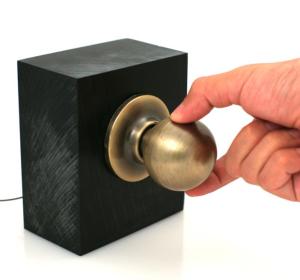
A smart door knob does more than just open or close doors. (Photo: Disney Research, Pittsburgh/Carnegie Mellon University)
Imagine having a doorknob that knows whether it should lock or unlock itself, based on how a user grips it; or a smartphone that silences itself if its user puts a finger to his or her lips; or a chair which automatically adjusts the lighting in a room by sensing whether the user is leaning forward or reclining in the chair.
These and other applications could soon be possible with a new sensing technique developed by a collaborative research team of Disney Research, Pittsburgh and Carnegie Mellon University.
The Touché system uses something its developers call Swept Frequency Capacitive Sensing (SFCS), a more advanced form of capacitive touch-sensing technology, which is currently used in the touchscreens of most smartphones.
But, unlike today’s touchscreens which only sense electrical signals at one frequency, Touché’s SFCS technology can monitor signals across a broad range of signals, which would make it possible for the object to not only sense the touch itself, but also to recognize a wide range of complex motions and configurations of the person touching it.
Since different body tissues can produce a wide range of capacitive properties, the SFCS device can take advantage of these differences and produce multiple results, according to its developers. And while today’s touchscreen technology senses signals from a person’s fingertips, the new Touché system can do so from different parts of the finger or hand as well as other parts of the human body.
“Signal frequency sweeps have been used for decades in wireless communication, but as far as we know, nobody previously has attempted to apply this technique to touch interaction,” said Ivan Poupyrev, senior research scientist at Disney Research, Pittsburgh at Carnegie Mellon University. “Yet, in our laboratory experiments, we were able to enhance a broad variety of objects with high-fidelity touch sensitivity. When combined with gesture recognition techniques, Touché demonstrated recognition rates approaching 100 percent. That suggests it could immediately be used to create new and exciting ways for people to interact with objects and the world at large.”
To demonstrate Touché’s technology, the researchers came up with what they called a smart doorknob. Their smart door knob, depending on whether it was grasped, touched with one or two fingers or if were perhaps pinched, provides appropriate signals that program a door to lock or unlock itself, permit an authorized guest to enter while preventing an unauthorized guest, or possible intruder, from entering the premises. The developers said they could also program the door knob to leave a vocal message when touched, such as “We’re away right now,” or “We’ll be back soon.”
The Disney/CMU researchers presented their findings today at CHI 2012, the Conference on Human Factors in Computing Systems in Austin, Texas, where they have been recognized with the group’s Best Paper Award.





















Comments are closed.